How to drain water from a Samsung washing machine?
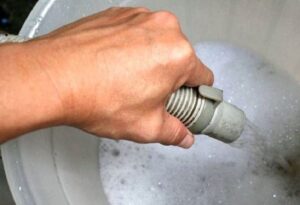 The machine cannot be repaired with a full tank. Before you begin diagnostics, you will have to drain the water from your Samsung washing machine. Otherwise, the process will be complicated by a flood, short circuit and final breakdown of equipment. You can “dry” the washing machine either through a special program or by force, manually. Let's consider each option with its pros and risks.
The machine cannot be repaired with a full tank. Before you begin diagnostics, you will have to drain the water from your Samsung washing machine. Otherwise, the process will be complicated by a flood, short circuit and final breakdown of equipment. You can “dry” the washing machine either through a special program or by force, manually. Let's consider each option with its pros and risks.
Fluid Removal Options
The safest way to empty the washing machine is in automatic mode - through the “Drain” program provided by the manufacturer. Everything is simple here: scroll the selector to the appropriate position and start the cycle. However, if the system freezes, this option does not work. If the “tidy” does not respond to the user’s commands, you will have to forcefully drain the water manually. “Manual” draining is started in the following ways:
- through the drainage sleeve, by gravity;
- unscrewing the garbage filter;
- emergency “opening” of the hatch;
- by uncoupling the pipe connecting the tank and the volute.
Before forced draining, equipment should be disconnected from communications: power supply and water supply.
Each of the forced options has its own risks and benefits. Much depends on the situation - sometimes only “opening” the drum is possible. In any case, you first need to turn off the power to the machine, turn off the water and assess the scale of the situation, and then choose the appropriate drainage method.
Unscrew the drain filter
The second safest option is draining through a garbage filter. You can resort to it almost always, even when the machine freezes during the washing process. The main thing is to act consistently and remember safety precautions.
The garbage filter is a plastic nozzle in the shape of a spiral, screwed into the drain volute and hidden behind the false panel in the lower right part of the body. The name is explained by the function of the element: waste water passes through the plastic, and debris and dirt cling to the plastic, not reaching the pump, which is more vulnerable to blockages. To start the emergency drain through the “trash can”, you need to unscrew it: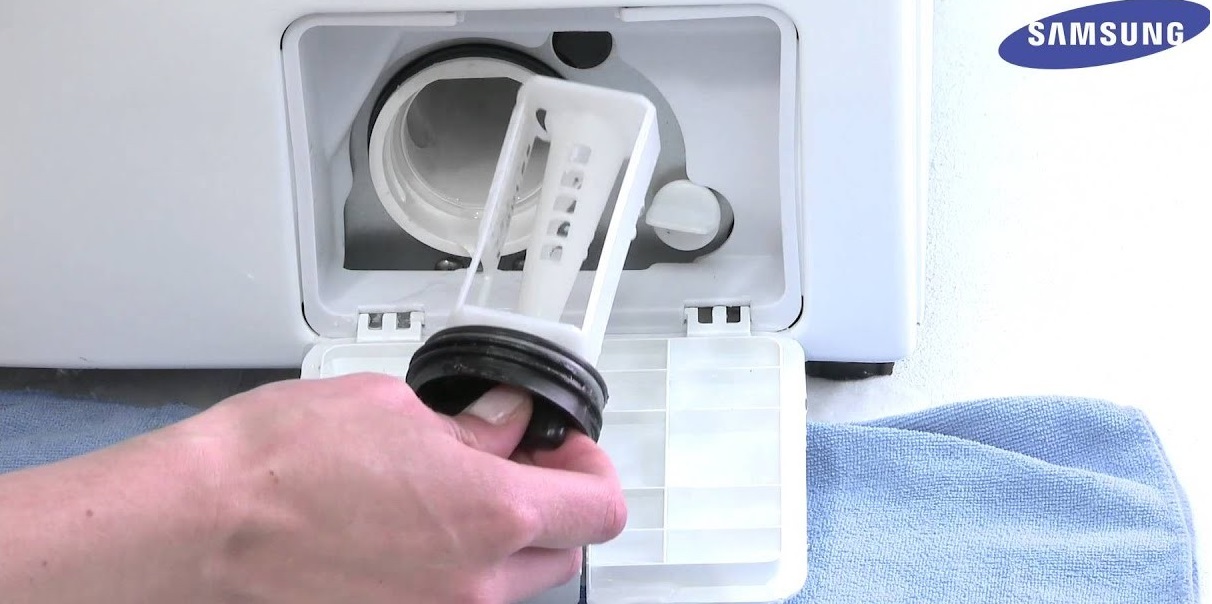
- use a flat screwdriver to pry off the technical hatch door;
- disconnect the panel from the body by releasing the latches;
- find the filter plug;
- place a container under the filter to collect water;
- lay an oilcloth or rag next to the machine;
- grab the protruding part of the cork;
- slowly turn the filter clockwise (you don’t need to take out the whole nozzle, otherwise the water flow will be too strong);
- wait until all the water has drained from the tank.
Be careful! Immediately after the end of the high-temperature regime, you cannot drain the water through the filter - you can get burned by boiling water!
Emptying the tank through a filter has only three disadvantages. The first is the impossibility of quickly draining immediately after a high-temperature cycle, since there is a high risk of getting burned by boiling water. The second is inevitable dirt, since it will be difficult to control the flow of sewage; something will definitely spill on the floor and equipment. The third drawback lies in the reverse installation: if the nozzle is not screwed in tightly enough, a leak will occur.
Drain sleeve
You can also drain the water from the tank at any stage of the cycle through the drain hose. You just need to free up access to the sewer pipe and find a place for sewage to drain: a sink, toilet or large basin. Then we get to work.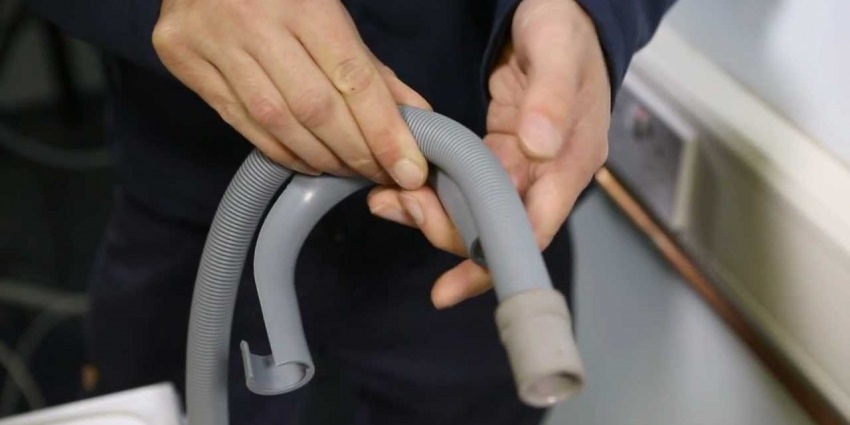
- We find the place where the machine’s drain hose attaches to the sewer riser.
- Loosen the clamp securing the corrugation.
- Disconnect the hose from the outlet.
- Remove the sleeve from the back panel of the washer (remove the hook-holder).
- We place the corrugation below the bottom of the machine’s tank, and lower the freed end into the toilet or basin.
- We watch how the liquid leaves the washing machine by gravity.
Washing machines equipped with non-return valves cannot be emptied through the drain hose.
The easiest way to empty the drum is through the drainage sleeve. But there is a significant “minus” - the method is not available on all washing machines. Modern Samsung models are equipped with a check valve that protects the machine from the “siphon effect” and spontaneous draining. In this case, lowering the corrugation down will not start drainage - the water will remain in the tank.
Open the hatch door
When it is not possible to drain the machine through a hose or filter, a more extreme option remains - open the drum and scoop out the water. But it’s better to first estimate the volume of liquid that has not been drained and be sure to tilt the equipment back. If the tank is very full, then after a sharp “opening” a flood cannot be avoided. The instructions are simple:
- move the machine away from the wall;
- tilt the washer back;
- substitute the pelvis;
- open the hatch;
- Scoop out the water from the drum.
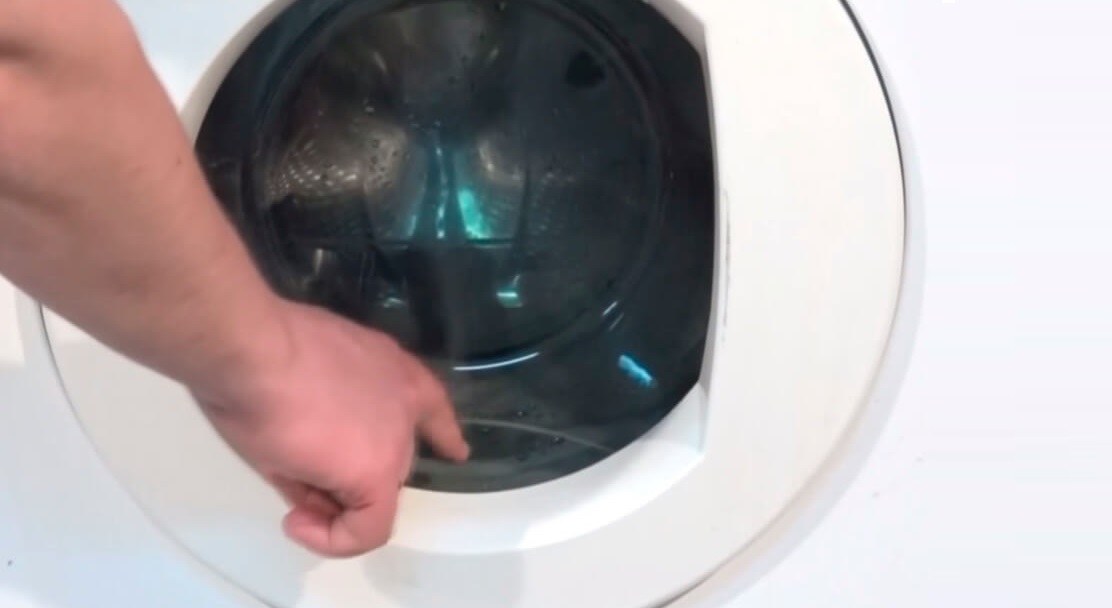
The difficulty arises at the stage of opening the door. If the machine freezes in the middle of a program, you cannot unlock the drum by pressing the handle - the electronic lock will remain on. We'll have to do it differently:
- find a long lace;
- insert a rope under the hatch door in the lock area;
- pull the lace until it reaches the lock;
- wait for the click and open the hatch.
Emptying the washing machine through the drum cannot be called easy. First, you will have to scoop out the soapy liquid for a long time, and then clean the room - dirty splashes and puddles cannot be avoided.It is worth considering that the result will not be one hundred percent: a certain part of the water will remain at the bottom of the tank and in the drain system.
The pipe between the volute and the drum
If the previous methods did not help, the last method remains is to forcefully empty the washer through the drum pipe. This option is more complicated, but more effective: all the liquid will be drained from the tank. It is also possible to eliminate the cause of the stagnation, since often the problem lies in a clogged hose. How to drain?
- Remove the back wall of the case.
- Find the pipe connecting the tank and the pump.
- Place a deep container and apply a cloth.
- Loosen the clamp holding the pipe.
- Remove the hose from the pump fitting and lower it into a container.
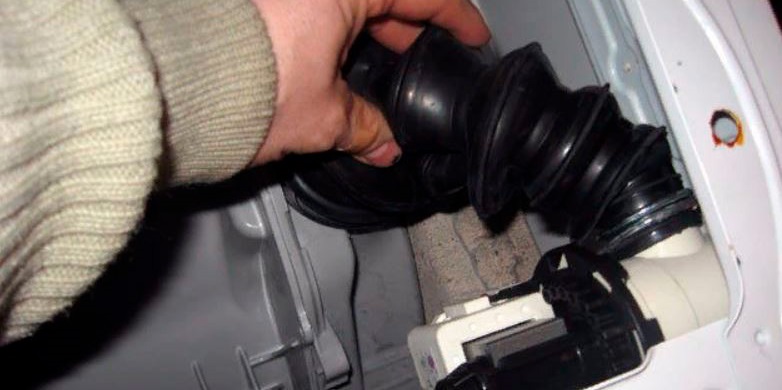
If water does not flow out when you disconnect the hose from the pump, then the problem is a blockage. You will have to loosen the second clamp and unhook the pipe from the tank. After draining, we clean the element and return it to its place.
Getting to the tank with the pipe is quite difficult. You should move the machine away from the wall, gain access to the bottom of the washing machine, crawl up to the drum, and only then, moving by touch, get down to business. Emptying the washing machine is only the first stage of repair. Afterwards there will be diagnostics, searching for the causes of the failure and eliminating the stagnation.
Interesting:
Reader comments
- Share your opinion - leave a comment



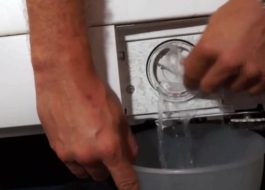


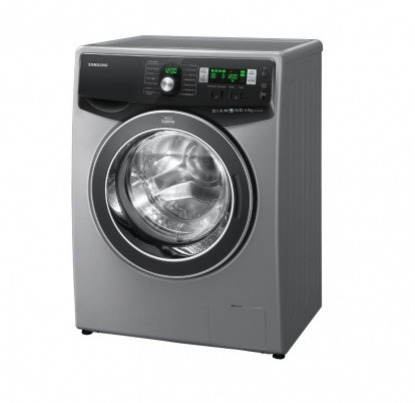



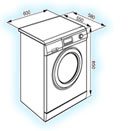







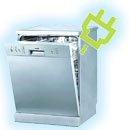


Add a comment